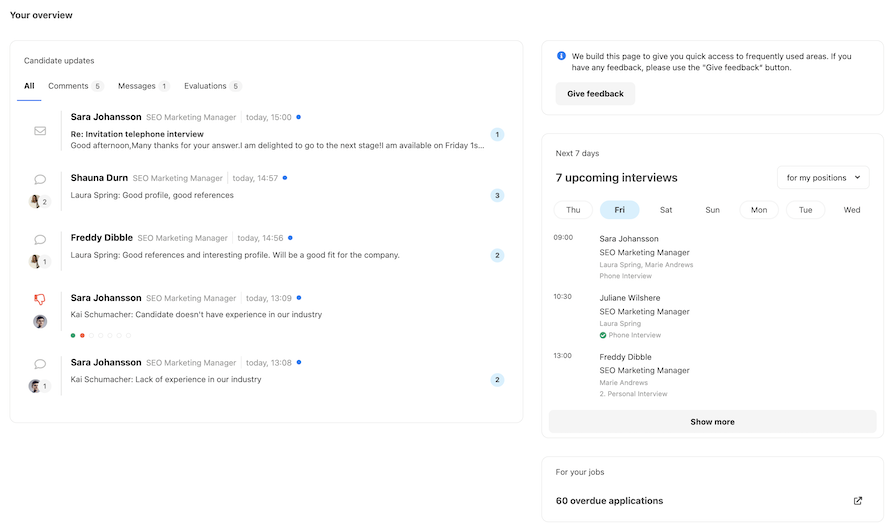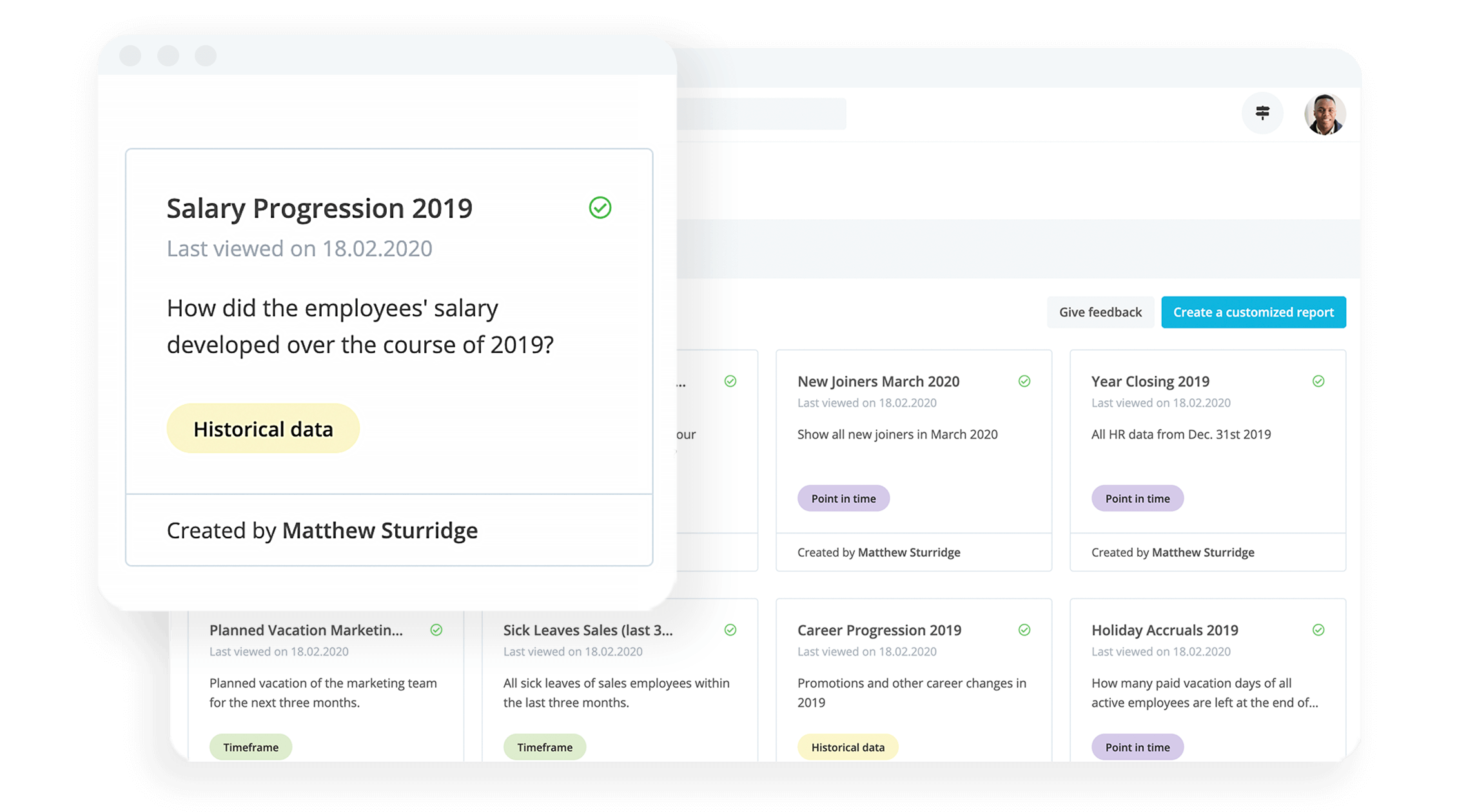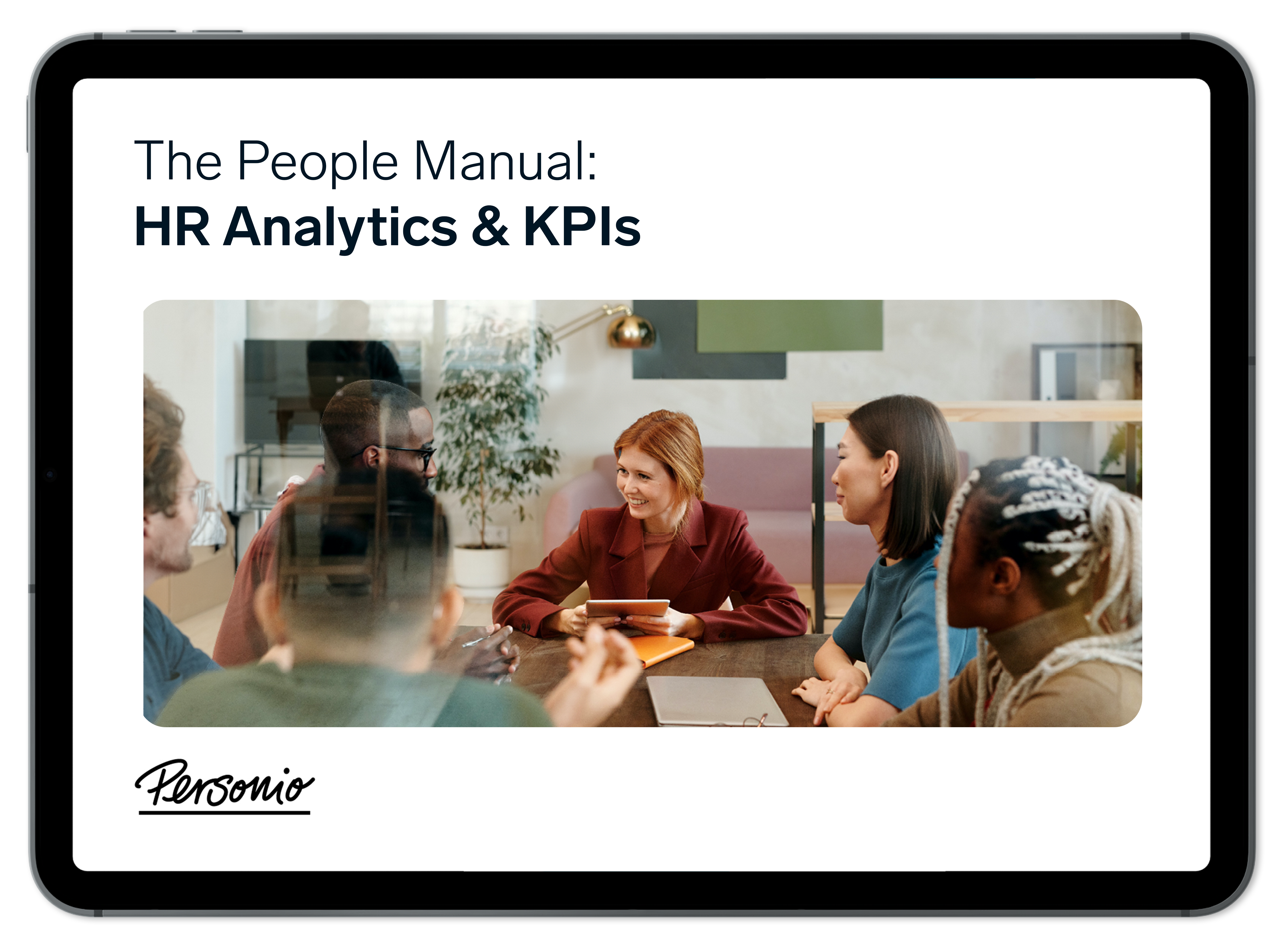
Optimise recruitment workflows
Optimise your recruitment workflow with Personio's powerful recruitment software.
Explore our product11 Recruiting KPIs Your Hiring Team Needs To Track

While recruitment KPIs may not be a treasured topic for many hiring teams, they are still essential. That’s because the advantages are clear: Using resources more efficiently, improving processes, and winning over both management and top talent. In this article, we’ll run through some key KPIs, why each matters, and more.
Download nowWhat are recruitment KPIs?

Recruitment KPIs are used by organisations, more specifically hiring and talent acquisition teams, to measure the strength and effectiveness of your overall recruiting activities.
They enable your organisation to measure, evaluate, and subsequently optimise individual initiatives. Overall, they are a key piece of planning out your recruiting strategy.
Why do recruitment KPIs matter?
As mentioned, hiring KPIs help to ensure that you’re doing all of the right things to find top talent. More importantly, they help quantify specific efforts to make sure that you continue doing what’s working and stop what’s not. And, since many things are now digital, recruitment KPIs matter because they have been never easier to accumulate.
That said, some teams may be nervous to introduce KPIs into their work. After all, they may feel that their work is often hard to quantify, so they want to make sure that it doesn’t strictly become a ‘numbers game.’ In cases like these, it is important to assure teams that numbers and KPIs are meant to augment performance, not define it entirely.
Ultimately, in using key figures, you can demonstrate contributions by teams, reach goals that gain the visibility of management, and generally offer more strategic insight into your HR efforts. Now, you need to select the right ones…
Which recruitment KPIs matter the most?

Amidst a collection of KPIs, how do you know which ones are the right ones for your organisation? The first step is to collect a handful that work for you. For that, they need to be clear, relevant, and meaningful.
So, how do you assess if a recruitment KPI is right for your company? Try this on for size — ask yourself, it is:
Relevant: Is the KPI important for achieving your business goals? Does it speak to success?
Trackable: Can you collect the necessary data seamlessly, permanently, and, if possible, automatically?
Benchmark–capable: Do you have comparative values from your industry or region for this metric?
If a KPI checks each of these boxes for your organisation, then we can recommend that you roll with it. Keep in mind, though, that different parts of your business (like commercial and industrial) may need different KPIs.
The People Manual: HR Analytics & KPIs

Over half a decade of collected insights on everything related to the KPIs that drive success in HR. Grab your free copy right now.
Download your copy todayQuantitative vs. qualitative KPIs
When defining your overall KPIs, it helps to strike a balance between quantitative and qualitative measures. Here are some examples of each when it comes to recruiting:
Quantitative KPIs | Qualitative KPIs |
|---|---|
Purely to the duration of various steps, like the number of applicants or the cost of new hires. | More about how things turned out, like candidate quality of satisfaction. |
The most prominent example of a quantitative recruitment KPI has to be time-to-fill or time-to-hire. Overall, though, when it comes to data collection, quantitative metrics are more pulled out of the hard numbers found in the process, whereas qualitative needs to be measured more from people (through surveys or other measures).
Finally, since quantity is relatively easy to measure (when compared to quality), there is the danger of focusing too much on it. That’s why balance is key, and why you need to not only measure both kinds of KPIs, but have a process in place that allows you to collect that data quickly and effectively.
Recruitment KPIs you need to know
In the table below, we present the top ten recruiting KPIs and what each of them seeks to measure…
Recruiting KPI | What It Measures |
|---|---|
Time to Fill | The time in between sending out an offer and having one signed. |
Cost per Hire | The estimated or exact cost of each employee hired. |
Channel Effectiveness | The overall success of a specific recruiting channel. |
Quality of Hire | How well candidates ultimately fit into your company. |
Candidate Satisfaction | The satisfaction of candidates throughout the recruiting process. |
Early Turnover | The number of employees who quit within 90 days at work. |
Cost of Vacancy | How much it costs to have a position unfilled over time. |
Offer Acceptance Rate | How many applicants accept offered contracts of employment. |
Time of Vacancy | The length of time that an average position remains open. |
Candidate Conversion Rate | The percentage of career site visitors who turn into candidates of any kind. |
Hiring Manager Satisfaction | Satisfaction of hiring managers at your company involved in the hiring process. |
How do you record your KPIs?
As we mentioned before, it helps to have ‘safeguards’ in place to make sure that you are recording data at every step. In a perfect world, that would also mean recording data automatically that could then be reported on in an instant.
It’s why HR software is such a critical topic when it comes to recruitment KPIs. That’s because you can do things like manage the entire applicant process. An applicant tracking system (ATS), in this sense, is able to record every step, including:
Publishing job offers
Managing applications
Documenting interviews and feedback
Creating new employees
In that process alone, you can track your number of applicants, the time it takes between steps, qualitative KPIs like feedback and experience, and how many candidates you ultimately create (and how long it takes to create them).
Have more questions about having an ATS? Read our FAQ on the matter.
Now, you have a lot of that foundational data, without any effort. And, you can access it anytime — partner this with an HR analytics platform, and you can have a report on your time-to-hire in mere moments.
Keep this in mind: Data grows over time, and a larger sample typically means greater insights and decision making. But, that means nothing if data collection is not done properly (or, in some cases, automatically).
The Entire Recruiting Journey In One Place

Personio’s Applicant Tracking System offers a single source of truth for all your recruiting efforts: Source, screen, interview, provide feedback on, and turn candidates into employees in one click. Take a look today to see how it works.
How Recruiting Works With PersonioHow should you interpret your KPIs?
On their own, KPIs are rarely meaningful. While they show how something has changed or trended over time, they do not allow for a final assessment or decision. Therefore, always look at your KPIs in context to draw valuable conclusions.
Here are two key examples:
You notice that the duration and costs of new hires has increased in a given period. This is actually a warning signal. In combination with the information that considerably more new employees than usual passed the probationary period, a different picture emerges. Obviously, the extra time and money spent on candidate selection were well invested.
Or you notice an increase in applications to your job postings via a job portal. Great! But it turns out: At the same time, you need considerably more applications to find a suitable candidate. The job portal is obviously addressing the wrong target group or you have not formulated your job posting optimally.
Measuring the success of recruitment KPIs
Now that you know the right metrics, and you have the system to gain accurate reports, how do you measure the success of your KPIs on a long-term basis?
Here’s a place to start:Match the performance of the metrics with your measures. How did the number of applications trend after you revised your job ads? Was the introduction of an additional telephone interview or aptitude test able to improve the quality of the selected candidates?
Ultimately, things get really exciting when you use your metrics not only for historical review and performance measurement, but to optimize your ongoing efforts.